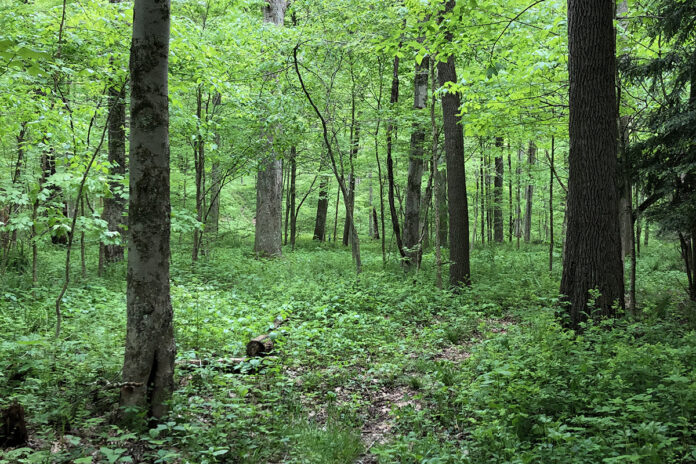
After a short tease in lower gas prices, we’re back to “eyes bulge out of your head in surprise” prices. Instead of a one-tank trip, we were looking for a less than a quarter-tank trip. This translated into finding a local trail for my boys and me to explore.
In the fall, they had discovered a great fishing hole and knew I would enjoy the trail to get there. Hellbender Bluff is a hidden gem consisting of 732 acres in Columbiana County. It is maintained by the Columbiana County Park District.
Namesake
Obviously, the park has quite an unusual name. A hellbender is a fully aquatic amphibian found in fast-flowing streams with cold temperatures.
The eastern hellbender can be found in streams from southern New York to northern Georgia. Spreading out from the Appalachian areas in Kentucky and Ohio, the eastern hellbender is also found in Indiana, Illinois, and Missouri.
The park could have been named Snot Otter Park, another name used for hellbenders. A mucous coating protects the stream-dwelling creature from diseases and predators.
The eastern hellbender can reach maturity at four to five pounds. It is the largest salamander in North America by weight. Typically, the average adult hellbender is around 20 inches but can reach up to 29 inches.
We did not see any hellbenders on our trip to the park. This is not unusual; hellbenders do not want to be seen. Their loose, wrinkly skin allows them to absorb oxygen straight from the water. They breathe completely through pores in their skin. They lurk under large rocks, waiting for the chance to attack an unsuspecting crayfish.
Being nocturnal, most activity of hellbenders takes place at night. Because hellbenders absorb oxygen directly from the water, they can easily be harmed by pollutants. They are an indicator species; they will not survive in heavily polluted areas.
The eastern hellbender was added to Ohio’s endangered animal list in the 1980s. Their continued population decline into the 2000s triggered a collective conservation effort. Local and state agencies worked together to clean the water, while at the same time amping up efforts to boost population numbers of the eastern hellbender.
The Columbiana Soil and Water Conservation District has released hundreds of eastern hellbenders raised in captivity into the Little Beaver Creek watershed.
The park was given the second part of its name “Bluff” because of the unique landscape feature of a sandstone cliff. The cliff or bluff was created when the top sandstone was not eroded by the water in the West Fork.
There are two separate areas to park and explore the West Fork of the Little Beaver Creek within Hellbender Bluff Park. On a previous trip, we parked in the lot off of East Liverpool Road in Madison Township. Several trailheads are near the East Liverpool Road parking lot.
The trails range in length from 2.3 miles (Bluff Trail) down to 0.35 miles (Reclamation Trail). There is also a pump track for biking enthusiasts and a picnic shelter.
Absorbed
On this trip, we explored the northern portion of the park, starting at the parking lot located on Lones Road. The hiking trail is narrow, a single track weaving through mature hemlocks and old-growth trees.
Just like an eastern salamander absorbs oxygen, we were absorbed into the forest. The farther we hiked, the more we were encompassed by vibrant green flora. Striped cream violets bordered the trail. Young wood ferns had unfurled into recognizable shapes dispersed along the ground. Large evergreens blocked out the blue sky; we were completely surrounded by shades of green and brown.
The trail led down to a honey hole for smallmouth bass. We didn’t have our fishing poles on this trip. As it turned out we didn’t have time for fishing anyways. We could hear raindrops on the leaves overhead.
We started the ascent a little faster, determined not to get drenched in the impending rainstorm. I did stop at one point to examine a rosy-colored trillium. I thought I had a new wildflower to add to my list for this spring.
As it turns out, a white trillium turns to shades of pink as it ages. I couldn’t add a new species, but rather I had gained more knowledge about spring ephemerals.
We were still relatively dry when we reached our car, thanks to the leaf canopy over the trail. Driving down Lones Road was similar to off-roading in a four-wheeler. It is a very narrow gravel road that follows a ledge over the valley.
I was very pleased with finding a new local trail to explore. I didn’t realize there was another world with ancient creatures so close to home.












